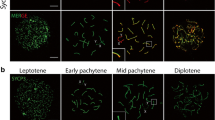Abstract
During oogenesis of the parthenogenetic stick insect Carausius morosus (2n ♀=61+XXX) pachytene is followed by a duplication of the desynapsed chromosomes, which results in a second type of pachytene (tetrapachytene) consisting of paired sister chromosomes (autobivalents). Electron microscopic studies on sections revealed that synaptonemal complexes (SCs) are formed during tetrapachytene only. This means that the parthenogenetically produced progeny have the genetic constitution of the mother. During spermatogenesis of rare fatherless males (2n=61 + XX) and intersexes (2n=61 +XXX) either an incomplete chromosome doubling (demonstrated by up to 10% additional DNA synthesis) or a complete chromosome doubling takes place during zygotene. EM studies on sections and spreads of germ cells of the first type of meiosis showed that unpaired lateral components (LCs), pieces of SCs and complete SCs are formed during pachytene only, the sex chromosomes being represented by unpaired thickened LCs. The incomplete SC formation reflects the complex heterozygosity of the chromosome complement. In the duplicated type SCs are found in tetrapachytene nuclei only; they are wider than the SCs in oocytes. The sex chromosome bivalents are represented by unpaired thickened LCs or partially paired LCs, in which localized chiasma formation was found. The idea is discussed that formation of SCs does not take place as long as a germ cell has been programmed either to replicate or to be able to replicate its chromosomes and that consequently SCs can be formed only once per meiosis.
Similar content being viewed by others
References
Counce SJ, Meyer GF (1973) Differentiation of the synaptonemal complex and the kinetochore in Locusta spermatocytes studied by whole mount electron microscopy. Chromosoma 44:231–253
Craig-Cameron TA, Southern DI, Pell PF (1973) Chiasmata and the synaptonemal complex in male meiosis of Glossina. Cytobios 8:199–207
Dietrich AJJ, Mulder RJP (1981) A light microscopic study of the development and behaviour of the synaptonemal complex in spermatocytes of the mouse. Chromosoma 83:409–418
Fletcher HL (1977) Localised chiasmata due to partial pairing: a 3D reconstruction of synaptonemal complexes in male Stetophyma grossum. Chromosoma 65:247–269
Fuge H (1979) Synapsis, desynapsis, and formation of polycomplex-like aggregates in male meiosis of Pales ferruginea (Diptera, Tipulidae). Chromosoma 70:353–373
Goldstein P, Triantaphyllou AC (1978) Occurrence of synaptonemal complexes and recombination nodules in a meiotic race of Meloidogyne hapla and their absence in a mitotic race. Chromosoma 68:91–100
Jones GH, Wallace BMN (1980) Meiotic chromosome pairing in Stetophyma grossum spermatocytes studied by a surfacespreading and silver-staining technique. Chromosoma 78:187–201
Joseph AM, Chandley AC (1984) The morphological sequence of XY pairing in the Norway rat Rattus norvegicus. Chromosoma 89:381–386
Koch P (1964) In Vitro-Kultur und entwicklungsphysiologische Ergebnisse an Embryonen der Stabheuschrecke Carausius morosus Br. Roux Arch Entwickl-Mech Org 155:549–593
Koch P, Pijnacker LP, Kreke J (1972) DNA reduplication during meiotic prophase in the oocytes of Carausius morosus Br. (Insecta, Cheleutoptera). Chromosoma 36:313–321
Moens PB (1969) The fine structure of meiotic chromosome polarization and pairing in Locusta migratoria spermatocytes. Chromosoma 28:1–25
Moses MJ (1977) Synaptonemal complex karyotyping in spermatocytes of the Chinese hamster (Cricetulus griseus). I. Morphology of the autosomal complement in spread preparations. Chromosoma 60:99–125
Oakley HA, Jones GH (1982) Meiosis in Mesostoma ehrenbergii ehrenbergii (Turbellaria, Rhabdocoela). I. Chromosome pairing, synaptonemal complexes and chiasma localisation in spermatogenesis. Chromosoma 85:311–322
Pijnacker LP, Ferwerda MA (1980) Sex chromosomes and origin of males and sex mosaics of the parthenogenetic stick insect Carausius morosus Br. Chromosoma 79:105–114
Pijnacker LP, Ferwerda MA (1982) Normal and BrdC-substituted chromosomes during spermatogenesis with an endomeiotic chromosome reduplication in Carausius morosus Br. Chromosoma 85:67–82
Pijnacker LP, Harbott J (1980) Structural heterozygosity and aneuploidy in the parthenogenetic stick insect Carausius morosus Br. (Phasmatodea: Phasmatidae). Chromosoma 76:165–174
Pijnacker LP, Koch P (1975) Complete and incomplete extra DNA reduplication during spermatogenesis of Carausius morosus Br. (Insecta, Phasmida). Chromosoma 49:269–278
Rasmussen SW (1973) Ultrastructural studies of spermatogenesis in Drosophila melanogaster Meigen. Z Zellforsch 140:125–144
Rasmussen SW (1975) Ultrastructural studies of meiosis in males and females of the c(3)G17 mutant of Drosophila melanogaster Meigen. CR Lab Carlsberg 40 (14): 163–173
Reynolds ES (1963) The use of lead citrate at high pH as an electron-opaque stain in electron microscopy. J Cell Biol 17:298–311
Solari AJ (1979) Autosomal synaptonemal complexes and sex chromosomes without axes in Triatoma infestans (Reduviidae; Hemiptera). Chromosoma 72:225–240
Solari AJ (1980) Synaptonemal complexes and associated structures in microspread human spermatocytes. Chromosoma 81:315–337
Solari AJ, Counce SJ (1977) Synaptonemal complex karyotyping in Melanoplus differentialis. J Cell Sci 26:229–250
Von Wettstein D, Rasmussen SW, Holm PB (1984) The synaptonemal complex in genetic segregation. Annu Rev Genet 18:331–413
Wandall A, Svendsen A (1983) The synaptonemal complex karyotype from spread spermatocytes of a dipteran (Aedes aegypti). Can J Genet Cytol 25:361–369
Weith A, Traut W (1980) Synaptonemal complexes with associated chromatin in a moth, Ephestia kuehniella Z. The fine structure of the W chromosomal heterochromatin. Chromosoma 78:275–291
Author information
Authors and Affiliations
Rights and permissions
About this article
Cite this article
Pijnacker, L.P., Ferwerda, M.A. Development of the synaptonemal complex of two types of pachytene in oocytes and spermatocytes of Carausius morosus Br. (Phasmatodea). Chromosoma 93, 281–290 (1986). https://doi.org/10.1007/BF00292750
Received:
Revised:
Issue Date:
DOI: https://doi.org/10.1007/BF00292750




